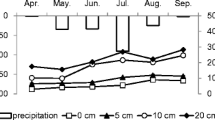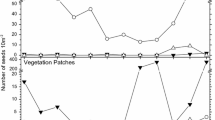Abstract
Facilitation is predicted to occur on coastal sand dunes as these ecosystems have the harsh physical conditions common during primary succession. In a tropical dune system on the Gulf of Mexico the spatial patterns of plant distribution were analyzed and the hypothesis that facilitation is the responsible mechanism was tested by monitoring changes in the micro-environment and performing a seedling planting experiment under natural conditions. Densities of seedlings and adults of late colonizer grasses were two to six times greater beneath the early colonizer shrub, Chamaecrista chamaecristoides, than in the exposed areas. Temperatures on the sand surface, wind speed and sand accretion were significantly reduced by the shade of Chamaecrista. Only phosphate contents during the dry season were significantly higher in sand in the shade than in exposed sand. In the field experiment, successful establishment of seedlings of two late colonizer grasses (Trachypogon plumosus and Schizachyrium scoparium) was low but was concentrated exclusively beneath the shrubs. The introduced plants were reproductive one year after onset of the experiment and remained vigorous after three years. The observed spatial aggregation among the target species may be a result of improved conditions in the shade of the shrub, which facilitated the survival and establishment of late colonizers. On top of the environmental amelioration, protection from recurrent disturbances such as substrate mobility is an additional beneficial effect of the shrub.
Similar content being viewed by others
References
Allen E.B. and Allen M.F. 1988. Facilitation of succession by the non-mycotrophic colonizer Salsola kali (Chenopodiaceae) on a harsh site: effects of mycorrhizal fungi. American Journal of Botany 75: 257–266.
Anderson J.M. and Ingram J.S.I. 1993. Tropical soils biology and fertility: a handbook of methods. C.A.V. International, Wallingford.
Alpert P. and Mooney H.A. 1996. Resource heterogeneity generated by shrubs and topography on coastal sand dunes. Vegetatio 122: 83–93.
Barros-Henriques R.P. and Hay J.D. 1992. Nutrient content and the structure of a plant community on a tropical beach-dune system in Brazil. Acta Oecologica 13: 101–117.
Berkowitz A.R., Canham C.D. and Kelly V. 1995. Competition vs.facilitation of tree seedling growth and survival in early successional communities. Ecology 76: 1156–1168.
Bertness M. and Hacker S. 1994. Physical stress and positive associations among marsh plants. American Naturalist 144: 363–372.
Bertness M.D. and Shumway S.W. 1993. Competition and facilitation in marsh plants. American Naturalist 142: 718–724.
Bertness M.D. and Yeh S.M. 1994. Cooperative and competitive interactions in the recruitment of marsh elders. Ecology 75: 2416–2429.
Bossdorf O., Schurr F. and Schumacher J. 2000. Spatial patterns of plant association in grazed and ungrazed shrublands in the semi-arid Karoo, South Africa. Journal of Vegetation Science 11: 253–258.
Callaway R.M. 1995. Positive interactions among plants. Botanical Review 61: 306–349.
Callaway R.M. and Walker L.R. 1997. Competition and facilitation: a synthetic approach to interactions in plant communities. Ecology 78: 1958–1965.
Callaway R.M., Kikvidze Z. and Kikodze D. 2000. Facilitation by unpalatable weeds mat conserve plant diversity in overgrazed meadows in the Caucasus Mountains. Oikos 89: 275–282.
Castellanos E.M., Figueroa M.E. and Davy A.J. 1994. Nucleation and facilitation in saltmarsh succession: interactions between Spartina maritima and Arthrocnemum perenne. Journal of Ecology 82: 239–248.
Chapin F.S. III, Walker L.R., Fastie C.L. and Sharman L.C. 1994. Mechanisms of primary succession following deglaciation at Glacier Bay, Alaska. Ecological Monographs 64: 149–175.
Connell J.H. and Slatyer R.O. 1977. Mechanisms of succession in natural communities and their role in community stability and organization. American Naturalist 111: 1119–1144.
Davidse G., Sousa M. and Chater A. 1994. Flora Mesoamericana. UNAM, Missouri Botanical Garden. The Natural History Museum, Missouri.
De Jong T.J. and Klinkhamer P.G.L. 1988. Seedling establishment of the biennials Cirsium vulgare and Cynoglossum off?cinale in a sand dune area: the importance of water for differential survival and growth. Journal of Ecology 76: 393–402.
Del Moral R. and Wood D.M. 1993. Early primary succession on the volcano Mount St. Helen's. Journal of Vegetation Science 4: 223–234.
Eccles N.S., Esler K.J. and Cowling R.M. 1999. Spatial pattern analysis in Namaqualand desert plant communities: evidence for general positive interactions. Plant Ecology 142: 71–85.
Grootjans A.P., Hartog P.S., Fresco L.F.M. and Esslink H. 1991.Succession and fluctuation in a wet dune slack in relation to hydrological changes. Journal of Vegetation Science 2: 545–554.
Harper J.L. 1977. Population biology of plants. Academic Press, New York.
Holmgren M. 2000. Combined effects of shade and drought on tulip poplar seedlings: trade-off in tolerance or facilitation? Oikos 90: 67–78.
Holmgren M., Scheffer M. and Huston M. 1997. The interplay of facilitation and competition in plant communities. Ecology 78: 1966–1975.
Houle G. 1997. No evidence for interspecific interactions between plants in the first stage of succession on coastal dunes in subartic Quebec, Canada. Canadian Journal of Botany 75: 902– 915.
Irwin H.S. and Barneby R.C. 1982. The American Casiinae. A synoptical revision of Leguminosae, Tribe Cassieae, subtribe Cassinae in the New World. Memoirs of the New York Botanical Garden., New York, part 2.
Jackson M.L. 1964. Análisis químico de suelos. Omega, Barcelona, España.
Kellman M. and Kading M. 1992. Facilitation of tree seedling establishment in a sand dune succession. Journal of Vegetation Science 3: 679–688.
Kellman M. and Roulet N. 1990. Nutrient flux and retention in a tropical sand-dune succession. Journal of Ecology 78: 664–676.
Lammerts E.J., Pegtel D.M., Grootjans A.P. and van der Veen A. 1999. Nutrient limitation and vegetation changes in a coastal dune slack. Journal of Vegetation Science 10: 111–122.
Levine J.M. 2000. Complex interactions in a streamside plant community. Ecology 81: 3431–3444.
Lichter J. 2000. Colonization constraints during primary succession on coastal Lake Michigan sand dunes. Journal of Ecology 88: 825–839.
Martínez M.L. and Moreno-Casasola P. 1993. Survival of seedling cohorts of a tropical legume on a sand dune system along the Gulf of Mexico: influence of germination date. Canadian Journal of Botany 71: 1427–1433.
Martínez M.L. and Moreno-Casasola P. 1996. Effects of burial by sand on seedling growth and survival in six tropical sand dune species. Journal of Coastal Research 12: 406–419.
Martínez M.L. and Moreno-Casasola P. 1998. The biological flora of coastal dunes and wetlands. 3. Chamaecrista chamaecristoides. Journal of Coastal Research 14: 162–174.
Martínez M.L., Moreno-Casasola P. and Rincón E. 1994. Sobrevivencia de una especie endémica de dunas costeras ante condiciones de sequía. Acta Botánica Mexicana 26: 53–62.
Martínez M.L., Moreno-Casasola P. and Vázquez G. 1997. Effects of disturbance by sand movement and inundation by water on tropical dune vegetation dynamics. Canadian Journal of Botany 75: 2005–2014.
Martínez M.L. and Rincón E. 1993. Growth analysis of Chamaecrista chamaecristoides (Leguminosae) under contrasting nutrient conditions. Acta Oecologica. 14: 521–528.
Martínez M.L., Vázquez G. and Sánchez-Colón S. 2001. Spatial and temporal dynamics during primary succession on tropical coastal sand dunes. Journal of Vegetation Science 12: 361–372.
Maun M.A. 1981. Seed germination and seedling establishment of Calamovilfa longifolia on Lake Huron sand dunes. Canadian Journal of Botany 59: 460–469.
Maun M.A. 1994. Adaptations enhancing survival and establishment of seedlings on coastal dune systems. Vegetatio. 11: 59– 70.
Maun M.A. 1998. Adaptations of plants to burial in coastal sand dunes. Canadian Journal of Botany 76: 713–738.
McLeod K.W. and Murphy P.G. 1977. Establishment of Ptelea trifoliata on Lake Michigan sand dunes. American Midland Naturalist 97: 350–362.
Moreno-Casasola P. 1982. Ecología de la vegetación de dunas costeras: factores físicos. Biotica. 7: 577–602.
Moreno-Casasola P. 1986. Sand movement as a factor in the distribution of plant communities in a costal dune system. Vegetatio. 65: 67–76.
Olff H., Huisman J. and van Tooren B.F. 1993. Species dynamics and nutrient accumulation during early primary succession in coastal sand dunes. Journal of Ecology 81: 693–706.
Olofsson J., Moen J. and Oksanen L. 1999. On the balance between positive and negative plant interactions in harsh environments. Oikos 86: 539–543.
Olsen S.R. and Dean L.A. 1965. Phosphorous Methods of soil analysis. Part 2. Agronomy 9 American Society of Agronomy, Madison, Wisconsin, USA.
Ortíz S. 1992. Heteromorfismo en semillas de Palafoxia lindenii Gray, una especie endémica de las dunas costeras del Golfo de México. BSc, Universidad Nacional Autónoma de México, México.
Peter C.I. 2000. Water requirements and distribution of Ammophila arenaria and Scaevola plumieri on South African coastal dunes. MSc Dissertation, Rhodes University, South Africa.
Pugnaire F.I. and Luque M.T. 2001. Changes in plant interactions along a gradient of environmental stress. Oikos 93: 42–49.
Pyke D. and Thompson J. 1986. Statistical analysis of survival and removal rate experiments. Ecology 67: 240–245.
SAS 1995. JMP Statistics and graphics guide. SAS Institute, Cary, NC, USA.
Shumway S.W. 2000. Facilitative effects of a sand dune shrub on species growing beneath the shrub canopy. Oecologia. 124: 138–148.
Sykes M.T. and Wilson J.B. 1990. An experimental investigation into the response of New Zealand sand dune species to different depths of burial by sand. Acta Botanica Neerlandica 39: 171–181.
Valverde T., Pisanty I. and Rincón E. 1997. Growth response of six tropical dune plant species to different nutrient regimes. Journal of Coastal Research 13: 497–505.
Valiente-Banuet A., Bolongaro-Crevenna A., Briones O., Ezcurra E., Rosas M., NÚñez H. et al. 1991. Spatial relationships between cacti and nurse shrubs in a semi-arid environment in central Mexico. Journal of Vegetation Science 2: 15–20.
Valiente-Banuet A. and Ezcurra E. 1991. Shade as a cause of the association between the cactus Neobuxbaumia tetetzo and the nurse plant Mimosa luisana in the Tehuacán Valley, Mexico. Journal of Ecology 79: 961–971.
Vázquez G., Moreno-Casasola P. and Barrera O. 1998. Interaction between algae and seed germination in tropical dune slack species: a facilitation process. Aquatic Botany 60: 409–416.
Wood D.M. and del Moral R. 1987. Mechanisms of early primary succession in subalpine habitats on Mount St. Helens. Ecology 68: 780–790.
Yarranton G.A. and Morrison R.G. 1974. Spatial dynamics of a primary succession: nucleation. Journal of Ecology 62: 417–428.
Young C.G., Dale M.R.T. and Henry G.H.R. 1999. Spatial pattern of vegetation in high arctic sedge meadows. Écoscience 6: 556–564.
Zar J.H. 1984. Biostatistical Analysis. Prentice-Hall, Inc., Englewood Cliffs, NJ, USA.
Author information
Authors and Affiliations
Rights and permissions
About this article
Cite this article
Martínez, M.L. Facilitation of seedling establishment by an endemic shrub in tropical coastal sand dunes. Plant Ecology 168, 333–345 (2003). https://doi.org/10.1023/A:1024406707115
Issue Date:
DOI: https://doi.org/10.1023/A:1024406707115




